“Well,” you now say, “what about all those cool Moon rocks? How did they get those? The Moon is, you know, the only source of Moon rocks, so doesn’t that prove that we were there?”
No, as a matter of fact, it does not prove that we were there, and as odd as it may sound, the Moon is not the only source of Moon rocks. As it turns out, authentic Moon rocks are available right here on Earth, in the form of lunar meteorites. Because the Moon lacks a protective atmosphere, you see, it gets smacked around quite a bit, which is why it is heavily cratered. And when things smash into it to form those craters, lots of bits and pieces of the Moon fly off into space. Some of them end up right here on Earth.
By far the best place to find them is in Antarctica, where they are most plentiful and, due to the terrain, relatively easy to find and well preserved. And that is why it is curious that Antarctica just happens to be where a team of Apollo scientists led by Wernher von Braun ventured off to in the summer of 1967, two years before Apollo 11 blasted off. You would think that, what with the demanding task of perfecting the hugely complex Saturn V rockets, von Braun and his cronies at NASA would have had their hands full, but apparently there was something even more important for them to do down in Antarctica. NASA has never offered much of an explanation for the curiously timed expedition.
Some skeptics have said that it is possible that Moon rocks could have been gathered from the Moon with robotic probes. But while it isn’t being argued here that unmanned craft haven’t reached the Moon, it seems virtually inconceivable that any unmanned spacecraft could have landed on and then been brought back from the surface of the Moon in the 1960s or 1970s. There is no indication that it can even be done today. It’s been more than three decades since anyone has claimed to do it, and that claim, by the Soviets, is highly suspect.
What is known for sure is that even some of the ‘debunking’ websites have, albeit reluctantly, acknowledged that meteorite samples gathered from Antarctica are virtually indistinguishable from NASA’s collection of Moon rocks. Of course, as we very recently learned, that is not true of all of NASA’s Moon rocks. Some of them apparently bear no resemblance at all to lunar meteorites. Instead, they look an awful lot like petrified wood from the Arizona desert.
Such was the case with a ‘Moon rock’ that the Dutch national museum has been carefully safeguarding for many years now, before discovering, in August of 2009, that they were in reality the proud owners of the most over-insured piece of petrified wood on the planet. The ‘Moon rock’ had been a gift to the Dutch from the U.S. State Department, and its authenticity had reportedly been verified through a phone call to NASA. I’m guessing that NASA was probably running low on meteorite fragments and figured the Dutch wouldn’t know the difference anyway. Or maybe Washington was a little peeved over the fact that Dutch newspapers reportedly called NASA’s bluff at the time of the first alleged Moon landing.
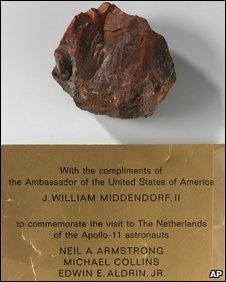
This is not to suggest, of course, that all of the Moon rocks passed out by NASA and the State Department are obvious fakes. Most, presumably, are of lunar origin – but that doesn’t necessarily mean they were gathered by American astronauts walking on the surface of the Moon; they could just as easily have come to Earth as meteorites. It is also possible that they are of otherworldly origin but not from the Moon at all – such as meteorites from other sources that have been collected here on Earth. The only way to know for sure what NASA’s Moon rocks are, of course, would be to compare them to a ‘control rock’ that is known to be from the Moon.
The problem, alas, is that the only known source for ‘authenticated’ Moon rocks is NASA, the very same folks who are known to occasionally hand out chunks of petrified wood. The other problem, it turns out, is that most of the Moon rocks are, uhmm, missing. Does anyone see a pattern developing here?
Since the discovery of the fake Moon rock in the Dutch museum, ‘debunkers’ have claimed that the fact that no other Moon rocks have been declared fake proves that the Dutch case is an isolated one. “After that announcement,” goes the argument, “wouldn’t every other country in possession of a Moon rock have rushed to have them authenticated? And since no other country has made a similar announcement, doesn’t that prove that the Moon rocks are real?”
At first glance, that would appear to be a valid argument. The problem, however, is that the vast majority of those countries can’t test their ‘Moon rocks’ because, shockingly enough, no one knows where they are! As the Associated Pressreported on September 13, 2009, “Nearly 270 rocks scooped up by U.S. astronauts were given to foreign countries by the Nixon administration … Of 135 rocks from the Apollo 17 mission given away to nations or their leaders, only about 25 have been located by CollectSpace.com, a Web site for space history buffs that has long attempted to compile a list … The outlook for tracking the estimated 134 Apollo 11 rocks is even bleaker. The locations of fewer than a dozen are known.”
It appears then that having a ‘control rock’ wouldn’t really be of much help after all, since nearly 90% of the alleged Moon rocks that we would want to test don’t seem to be around any more.
“But I have also heard,” you now say, “that photos have been taken of the equipment left behind by the Apollo astronauts on the surface of the Moon, like the descent stages of the lunar modules. How do you account for that?”
It is certainly true that there have been numerous claims over the years that various satellites or unmanned space probes or space telescopes were going to capture images that would definitively prove that man walked on the Moon, thus settling the controversy once and for all. And in recent years, the ‘debunkers’ have openly gloated whenever such an announcement has been made, boldly proclaiming that all the “hoax believers” will soon be exposed as the ignorant buffoons that they are.
Despite all the promises, however, no such images have ever been produced, a fact that the ‘debunkers’ seem to conveniently overlook while forever rushing to announce that the hoax theories are about to be discredited.
For at least two decades now, since the launch of the Hubble Space Telescope, we have been promised dazzling images of the lunar modules sitting on the surface of the Moon. The Hubble technology, needless to say, never managed to deliver. More recently, in 2002, the European Southern Observatory’s Very Large Telescope (whose inventor apparently coined the name while watching Sesame Street) was also supposed to deliver the promised images. And seven years later, the fabled images have yet to materialize.
In March of 2005, Space.com boldly announced that a “European spacecraft now orbiting the Moon could turn out to be a time machine of sorts as it photographs old landing sites of Soviet robotic probes and the areas where American Apollo crews set down and explored. New imagery of old Apollo touchdown spots, from the European Space Agency’s (ESA) SMART-1 probe, might put to rest conspiratorial thoughts that U.S. astronauts didn’t go the distance and scuff up the lunar landscape. NASA carried out six piloted landings on the Moon in the time period 1969 through 1972. Fringe theorists have said … that NASA never really went to the Moon.”
I’m guessing that most “fringe theorists” will continue to harbor “conspiratorial thoughts” for as long as pompous websites like Space.com continue making arrogant proclamations such as that and then not following them up with so much as a single image in well over four years.
Who knew, by the way, that the European Space Agency had the technology and the budget to send a spacecraft off to orbit the Moon? Who knew that the Europeans even had a space agency? I wonder, given that they obviously have the technology to send spacecraft to the Moon, why they haven’t sent any manned missions there? I would think that it should be fairly easy to send some guys to at least orbit the Moon … right? I mean, all they have to do is add a couple seats to the spacecraft design that they already have and they should be ready to go.
Here is another thing that I sometimes wonder about: why it is that in the 1960s we possessed the advanced technology required to actually land men on the Moon, but in the 21st century we don’t even have the technology required to get an unmanned craft close enough to the Moon to take usable photographs? Or could it be that there’s just nothing there to photograph?
Just this year, NASA itself boldly announced that it’s “Lunar Reconnaissance Orbiter, or LRO, has returned its first imagery of the Apollo moon landing sites. The pictures show the Apollo missions’ lunar module descent stages sitting on the moon’s surface, as long shadows from a low sun angle make the modules’ locations evident … ‘The LROC team anxiously awaited each image,’ said LROC principal investigator Mark Robinson of Arizona State University. ‘We were very interested in getting our first peek at the lunar module descent stages just for the thrill – and to see how well the cameras had come into focus. Indeed, the images are fantastic and so is the focus.’”
Sounds promising, doesn’t it? The images, however, hardly live up to the billing. They are, in fact, completely worthless. All they depict are tiny white dots on the lunar surface that could be just about anything and that would barely be visible at all without those handy “long shadows from a low sun angle.” And the weird thing about those shadows is that, in the very same NASA article, it says that “because the sun was so low to the horizon when the images were made, even subtle variations in topography create long shadows.” And yet while it is perfectly obvious that there are more than just “subtle variations” in the lunar topography in the images, the alleged lunar modules are the only things casting the long shadows.
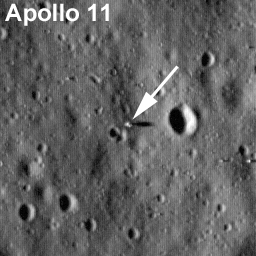
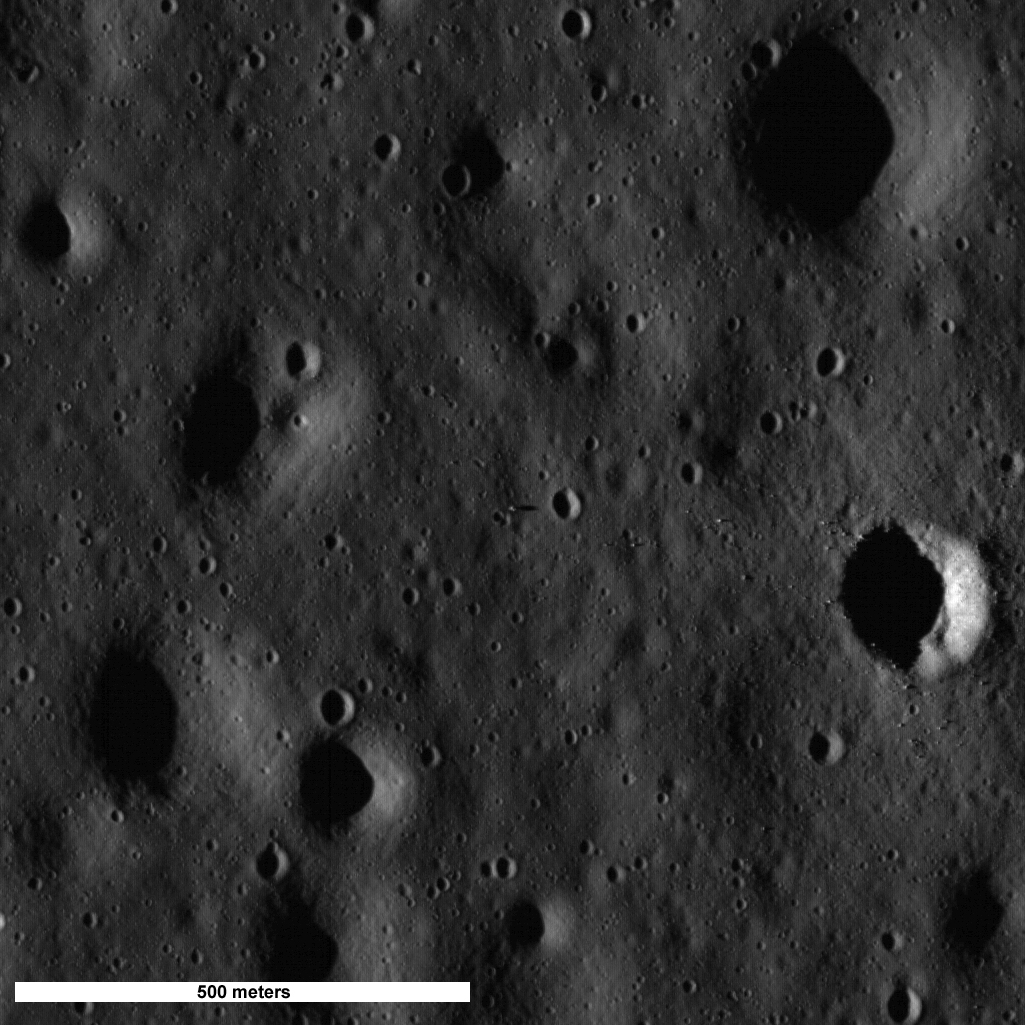
Even if we give NASA every benefit of the doubt and assume that the images have not been amateurishly Photoshopped and that the indiscernible white dots are indeed something of man-made origin, the most likely culprit would be those Soviet robotic probes mentioned by Space.com, which presumably did land on the Moon. A number of those probes, which were part of the Apollo-era Luna Program, were very similar in size and shape to the lunar modules – certainly enough so that images of much higher resolution would be required to make a definitive judgment.
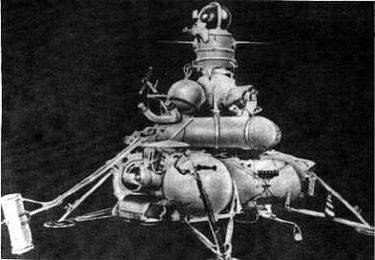
Actually, after studying the image above, of one of the alleged Luna probes, I’m going to have to say that the Soviets were lying their asses off almost as much as NASA was. There is no way I’m going to buy into the notion that the Soviets sent a freeform abstract sculpture, which appears to have been constructed by Fred Sanford and Granny Clampett, on a 234,000 mile journey from the Earth to the Moon. Careful study of the central area of the photo, however, does reveal why the spacecraft were known as ‘probes.’ I wonder if they were capable of performing docking maneuvers?
According to NASA, Japan and India have also sent unmanned orbiting spacecraft to the Moon in recent years, as has China. As with the ESA’s and NASA’s orbiters, they too have failed to return any images of Earthly artifacts left behind on the surface of the Moon. If the hoax ‘debunking’ websites are to be believed, by the way, the reason that no one has returned to the Moon in thirty-seven years is because we pretty much already tapped that celestial body for all the information it had to offer. There’s really, you see, nothing much left to see there.
A ‘debunking’ article posted by ABCNews.com, for example, quoted Val Germann, the president of the Central Missouri Astronomical Association, as saying, “There’s no reason to go back … Quite frankly, the moon is a giant parking lot, there’s just not much there.” I wonder why it is then that just about everyone seems to want to send unmanned probes there, or to train enormously powerful telescopes on the Moon’s surface? What could they possibly learn about the “parking lot” from those distances that our astronauts didn’t already discover by actually being there?
Some True Believers also claim that what was dubbed the Lunar Laser Ranging experiment also proves that we really went to the Moon. As the story goes, the astronauts on Apollo 11, Apollo 14, and Apollo 15 all allegedly left small laser targets sitting on the lunar terrain (one of them can be seen in the official NASA photo reproduced below), so that scientists back home could then bounce lasers off the targets to precisely gauge the distance from the Earth to the Moon.
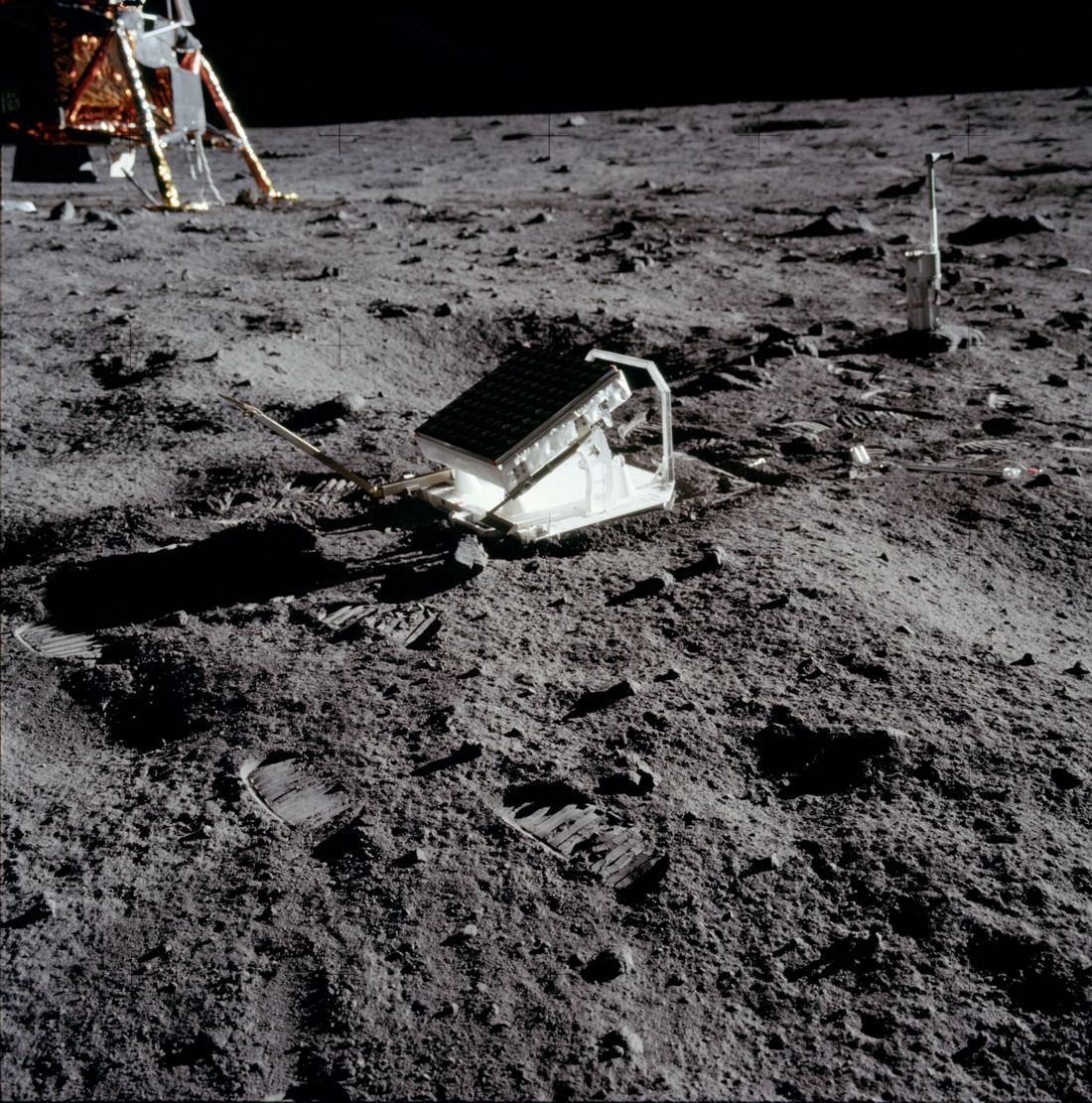
According to the ‘debunkers,’ the fact that observatories to this day bounce lasers off the alleged targets proves that the Apollo missions succeeded. It is perfectly obvious though that the targets, if there, could have been placed robotically – most likely by the Soviets. It is also possible that there are no laser targets on the Moon. In December 1966, National Geographic reported that scientists at MIT had been achieving essentially the same result for four years by bouncing a laser off the surface of the Moon. The New York Times added that the Soviets had been doing the same thing since at least 1963.
There was much about the Apollo flights that was truly miraculous, but arguably the greatest technological achievement was the design of the lunar modules. Has anyone, by the way, ever really taken a good look at one of those contraptions? I mean a detailed, up-close look? I’m guessing that the vast majority of people have not, but luckily we can quickly remedy that situation because I happen to have some really good, high-resolution images that come directly from the good people at NASA.


While what is depicted in the images may initially appear, to the untrained eye, to be some kind of mock-up that someone cobbled together in their backyard to make fun of NASA, I can assure you that it is actually an extremely high-tech manned spacecraft capable of landing on the surface of the Moon. And incredibly enough, it was also capable of blasting off from the Moon and flying 69 miles back up into lunar orbit! Though not immediately apparent, it is actually a two-stage craft, the lower half (the part that looks like a tubular aluminum framework covered with Mylar and old Christmas wrapping paper) being the descent stage, and the upper half (the part that looks as though it was cobbled together from old air conditioning ductwork and is primarily held together, as can be seen in the close-up, with zippers and gold tape) being the ascent stage.
The upper half, of course, is the more sophisticated portion, being capable of lifting off and flying with enough power to break free of the Moon’s gravity and reach lunar orbit. It also, of course, possessed sophisticated enough navigational capabilities for it to locate, literally out in the middle of fucking nowhere, the command module that it had to dock with in order to get the astronauts safely back to Earth. It also had to catch that command module, which was orbiting the Moon at a leisurely 4,000 miles per hour.
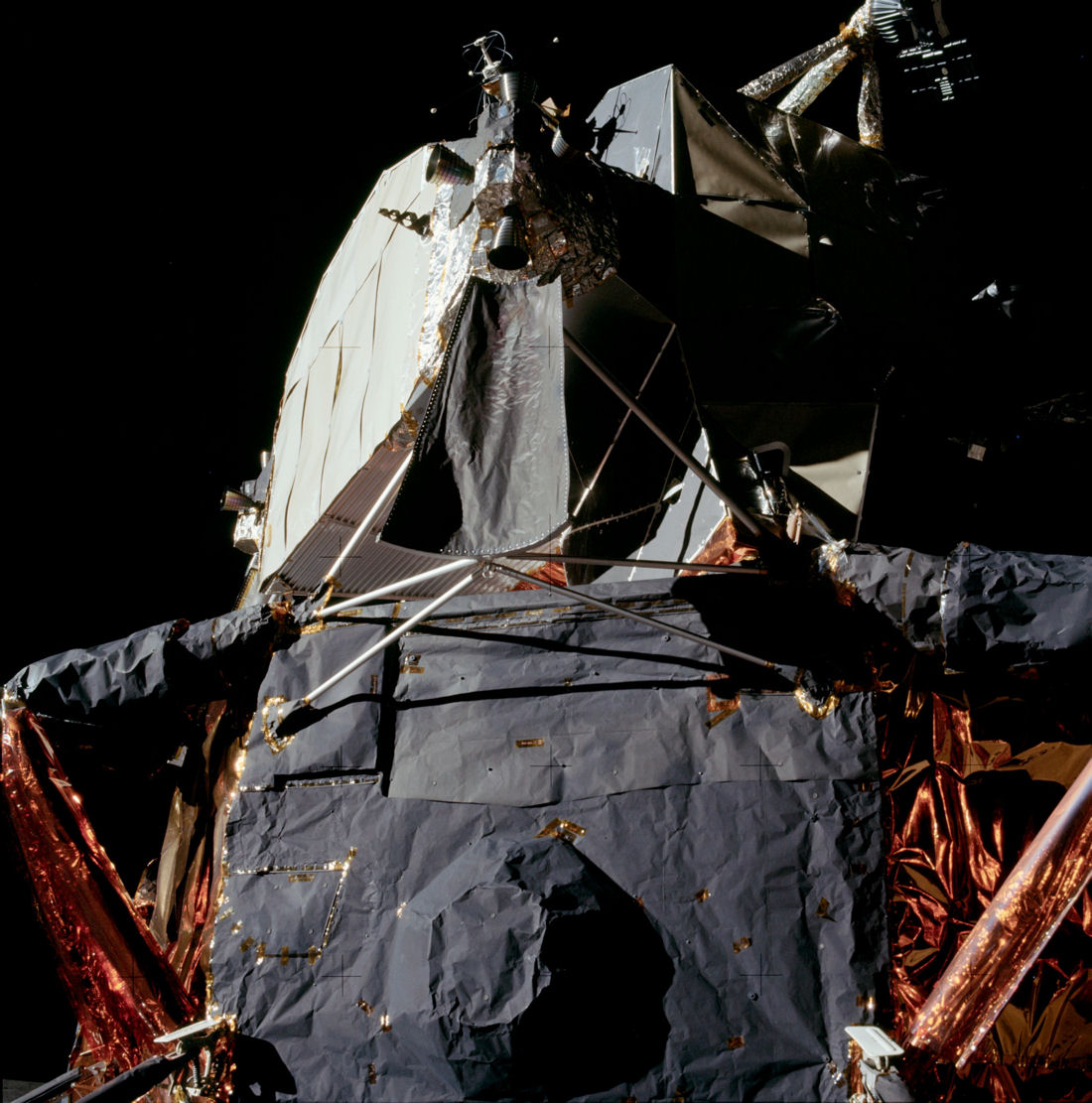
But we’ll get to all that a little later. I think we can all agree for now that such a sleek, stylish, well-designed craft would have no problem flying with that kind of power, precision and stability.
There is one thing that appears to be a problem though: how did they get everything on board the modules that they were going to need to successfully complete their missions? According to NASA, the modules were (excluding the landing pads) only about twelve feet in diameter. That is obviously not a whole lot of space to work with, so let’s try to think of everything that we would need if we were astronauts venturing off on a little journey to the Moon.
First of all, of course, we have to account for the space taken up by the various components of the ship itself. There is the framework and the, uhh, let’s call it the ‘fuselage’ of the craft. And we will need a lot of very sophisticated navigation and guidance and communications equipment, all of which took up a whole lot more space back in the ‘60s than it would today. And then, needless to say, there is the power supply – or rather multiple power supplies. For the descent stage, there is the reverse-thrust rocket that allegedly allowed the craft to make a soft landing on the Moon. And then for the ascent stage, there is a powerful rocket to propel the random bundle of sheet metal into lunar orbit. There are also additional rockets to allegedly stabilize the vessel in flight (the random clusters of what look like bicycle horns).
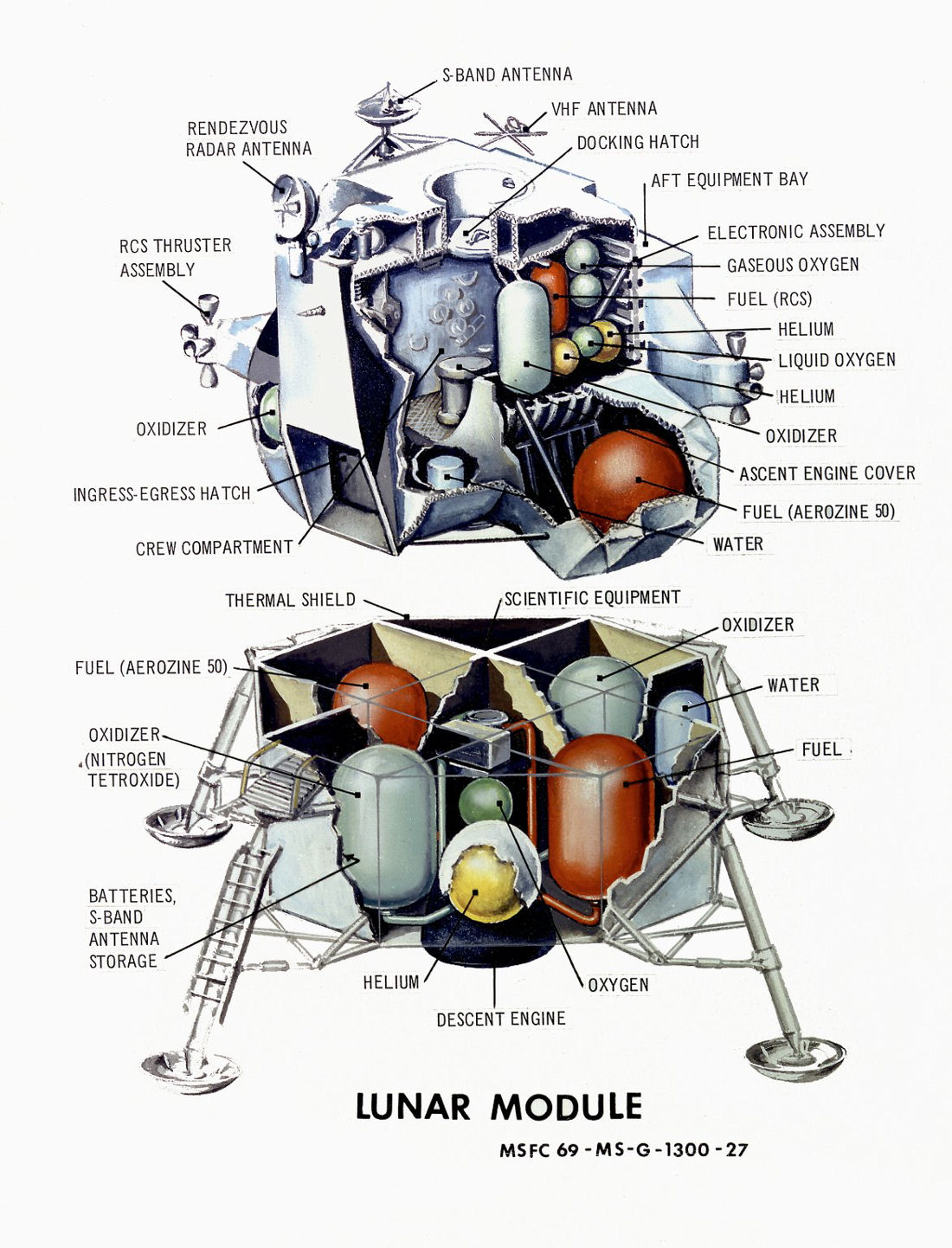
Next up is the massive amount of fuel that will be required to power all of those rockets, for both the ascent and descent stages of the mission. The ascent stage in particular is going to be a bit of a fuel hog, as ascending 69 miles and breaking free of the Moon’s gravity is a formidable challenge, to say the least. Though it may only have 1/6 the gravitational pull of Earth, keep in mind that it is still a force strong enough to create the tides here on Earth, 234,000 miles away.
I’m not a rocket scientist, by the way, so I am sure that there are quite a few components that I am leaving off of my lunar module – but that’s okay, because our spaceship is already feeling really cramped just with the stuff listed so far. And we’re just getting started.
Next we have to include everything required to keep ourselves alive and well. We aren’t going to be there very long, of course, and space is obviously limited, but we will still require some basic amenities. We will, after all, have to sleep somewhere in the ship, won’t we? Or will we just unfold cots on the lunar surface? We will also require a sanitation/septic system of some kind. Or did those missions bring about another ‘first’ that NASA has been reluctant to brag about? Was Neil Armstrong, unbeknownst to the American people, the first man to take a dump on lunar soil? Or was it Buzz Aldrin? Which astronaut has the distinction of being the first to soil the lunar landscape?
Anyway, getting back to our packing list, in addition to a sanitation system, it is imperative that we bring along an adequate supply of food, water and oxygen – and not just enough to last for the planned duration of our visit, but enough to supply a small safety cushion should anything go wrong. Because from what I have heard, running out of food, water or oxygen while on the Moon can really fuck up an otherwise perfectly good trip. The oxygen is especially important, so we’re going to need a really good, reliable system to deliver that oxygen, and to, you know, recharge the oxygen tanks in our spacesuits so we can walk around on the Moon and jump like 8” or 9” high like the Apollo guys did. And a back-up oxygen system probably wouldn’t be a bad idea.
We are also going to need to install a top-of-the-line heating and cooling system. Probably several of them, actually. Because the ‘weather’ on the Moon, so to speak, can be a bit unpleasant. According to the experts over at NASA, daytime highs average a balmy +260° F, but it cools off quite a bit at night, dropping to an average of -280° F. If you’re looking for anything between those two extremes, you won’t really find it on the Moon. It’s pretty much one or the other. If you’re in the sun, you’re going to be boiled alive, and if you’re out of the sun, you’re going to be flash frozen.
I’m not at all sure how the air conditioning system is going to work, come to think of it, since air conditioning requires a steady supply of – and please stop me if I am stating the obvious here – air. And the Moon doesn’t really have a lot of that.
It would help, of course, if our spacecraft was heavily insulated in some manner, but that doesn’t appear to be the case, so we’ll need a really, really good heating and cooling system, and plenty of freon or whatever it is that we’ll need to keep it running. So now we have to add all of the following to our already crowded spacecraft: ourselves; a minimal amount of room to sleep and otherwise take care of the basic necessities of life; some type of plumbing and sewage system; a really good heating and cooling system, and a considerable supply of food, water and oxygen. And we’re still not done packing for our trip.
Now we have to add all of the equipment that will be required to maintain the ship and complete our planned missions. First of all, we are definitely going to need to pack an exhaustive supply of spare parts and a wide variety of tools. That is an absolute must. From what I have heard, there are a few stores on the Moon that do stock spaceship parts, but they tend to close on certain days of the week. And orders from the mainland can take a frustratingly long time to arrive, so it’s always best to be prepared for any emergency. There are a lot of things that can go wrong with our spaceship and the only thing harder than finding a good mechanic here on Earth is finding one on the Moon.
And then, of course, we’ll have to bring all the fancy testing equipment that we will use to pretend to conduct experiments. Some of it is quite bulky, so we’ll need to set aside some storage space for all of that. And we’re going to need some additional storage space to bring back all those petrified wood samples, but we should have room for that after we jettison most of the fake testing equipment.
Our spaceship is now so ridiculously overloaded that we may have had to add a roof-rack and we still aren’t quite done yet. We still have a couple more items to pack, and we probably should have gotten them on sooner because they are going to require a lot of space. Since this is one of the later Apollo flights, you see, we also have to pack a dune buggy, otherwise known as a lunar rover. And the rovers, according to NASA, are a full ten feet long, just two feet less than the diameter of our craft. But not to worry – according to NASA, the rovers (pictured below) folded up to the size of a large suitcase. When released, they would just sort of magically unfold and snap into place, ready to roam the lunar terrain.
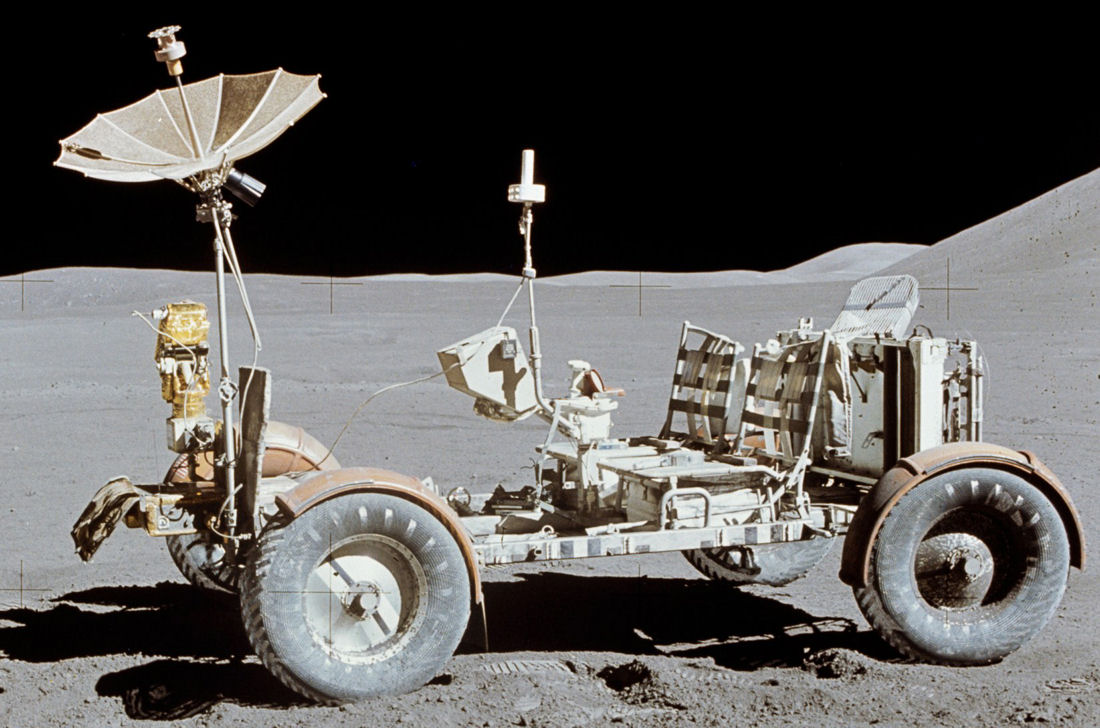
To be perfectly honest, I’m not really sure why we have to pack the damn rover. There is no real compelling reason to take it to the Moon … except for the fact that they make for good TV, and that seems to be of paramount importance. And as can be seen below, it should easily fit into our spaceship.
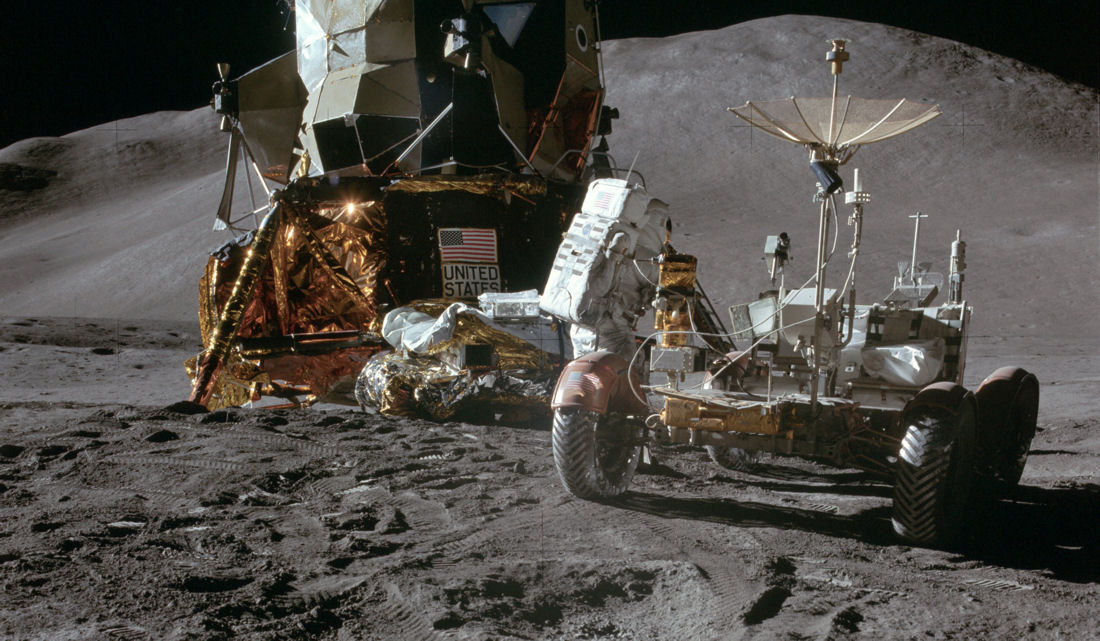
One last thing we’re going to need is a whole lot of batteries. Lots and lots of batteries. That’s going to be the only way to power the ship while we’re on the Moon, and we’ll definitely need to run the communications systems, and the oxygen supply system, and the heating and cooling system, and the cabin lights, and the television cameras and transmitters, and all the testing equipment, and our spacesuits, and that damn rover. And we won’t be able to recharge any of the various batteries, so we’re going to need a lot of back-ups. Especially of the really big batteries that run the ship. We may need a separate ship just to carry all the batteries we’re going to need.
By the way, I can’t possibly be the only one who is disappointed that we never followed up on that breakthrough folding-vehicle technology. If we had folding Moon buggies back in the early 1970s, then how far behind could folding automobiles have been had we chosen to stay the course? Had NASA’s pioneering vision been followed up, we could all be folding up our cars and tucking them away under our office desks. But as with all the Apollo technology, it existed only in that specific period of time and has now, sadly, been lost to the ages.
NASA has done something very odd, by the way, with the lunar module that it has on display for museum visitors to marvel at: it has staffed it with miniature astronauts wearing miniature space suits (the module may also be scaled slightly larger than the ‘real’ modules that allegedly landed on the Moon). I wonder why they would do that? I’m pretty sure that Buzz and Neil were of normal stature, so the only reason that I can think of that they would use miniature astronauts would be to portray the modules as larger than what they actually were. And in better condition too. Did they pick up the ones they sent to the Moon at a used car lot?
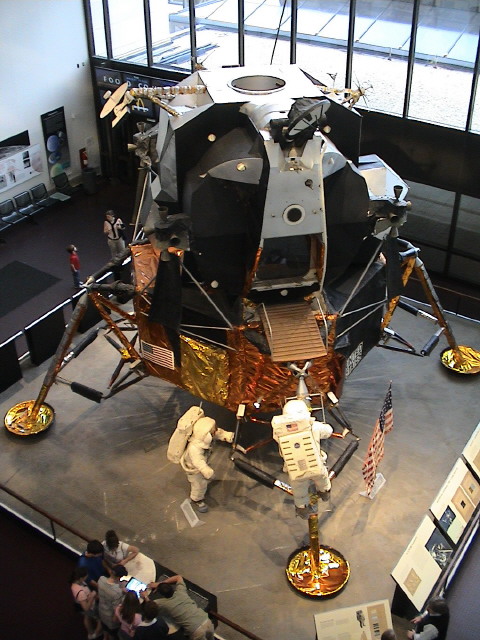
Before moving on, I need to emphasize here just how sophisticated the lunar modules actually were. These remarkable spacecraft – and I understandably get a little choked up here talking about this, because I am just so damn proud of our team of Nazi scientists – managed to make six perfect take-offs from the surface of the Moon! And understand here people that they did that, amazingly enough, with completely untested technology!
You can’t duplicate the conditions on the Moon here at home, you see, or even provide a rough approximation. And since no one had ever been to the Moon, they didn’t know exactly what to replicate anyway, so this part of the mission was pretty much of a crapshoot. Conditions on the Moon are, to say the least, a bit different than here on Earth. The gravitational pull is only about 1/6 of what it is here. And then there is that whole ‘lack of atmosphere’ thing. And the decidedly unearthly temperatures. And then, of course, there are the high levels of space radiation.
I’m quite sure that we had the best minds available working on the Apollo project, but none of them could have accurately predicted and compensated for how all those unearthly conditions would combine to affect the flight potential of the lunar modules. So the ability of the modules to actually blast off from the Moon and fly was, at best, a theoretical concept.
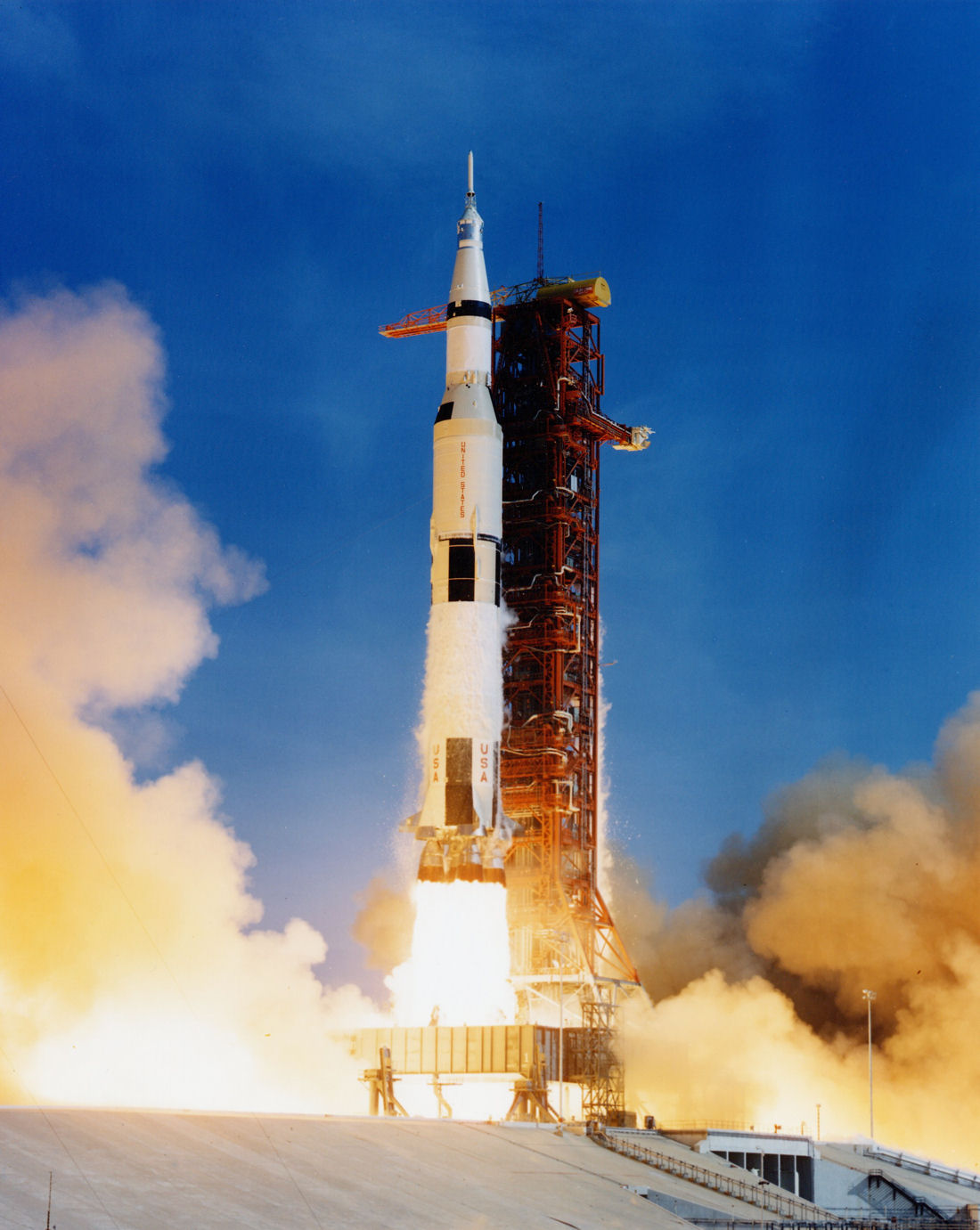
It is also important to remember that, unlike the initial blast-off from Earth (seen above), which involved the collective efforts of thousands of people and the use of all types of peripheral equipment, the astronauts taking off from the Moon had only themselves and a strange vessel that looked like it had been salvaged from the set of Lost in Space. What would you be thinking, by the way, if you suddenly found yourself on the surface of the Moon with what looked like a cheap movie prop as your only way home? Would you feel comfortable hanging around for a few days doing experiments, confident that, when the time came, the untested contraption behind you would actually get you back home from the Moon? Or would the words “bad career choice” be running through your head?
But as it turns out, America kicked ass back then and those lunar modules performed like champions every single time! They didn’t even need any modifications! Despite the completely foreign environment, they worked perfectly the very first time and every time thereafter!
On Earth, it took many long years of trial and error, many failed test flights, many unfortunate accidents, and many, many trips back to the drawing board before we could safely and reliably launch men into low-Earth orbit. But on the Moon? We nailed that shit the very first time.
Today, of course, we can’t even launch a space shuttle from right here on planet Earth without occasionally blowing one up, even though we have lowered our sights considerably. After all, sending spacecraft into low-Earth orbit is considerably easier than sending spacecraft all the way to the friggin’ Moon and back. It would appear then that we can draw the following conclusion: although technology has advanced immeasurably since the first Apollo Moon landing and we have significantly downgraded our goals in space, we can’t come close to matching the kick-ass safety record we had in the Apollo days.
The thing is that, back in the frontier days, we didn’t need all that fancy technology and book-learnin’ to send Buzz and the boys to the Moon and back. Back then, we had that American can-do spirit and we just cowboyed up and MacGyvered those spaceships to the Moon. All we needed was an old Volkswagen engine, some duct tape and a roll of bailing wire. Throw a roll of butt-wipe and a little Tang on board and you were good to go.
And how about the speed with which we cranked out those Apollo spacecraft? Once we figured out how to make them, we were stamping them out like Coke cans. We fired off seven of them in just under three-and-a-half years, or about one every six months. Given the extreme complexity of those vessels, and the fact that every component had to perform flawlessly under largely unknown conditions, that is a pretty impressive production schedule. America, I think it is safe to say, totally rocked back then!

Thank you for bringing these essays back . I was so impressed with Mr McGowan back then and am sorry that he died. I am so glad that you are keeping his work and spirit alive. Bob a.
While I enjoy the articles and writing style, there is a problem in the narrative that it was all a hoax.
1. You do NOT need a shit ton of girl to get to the moon and back. The engineers in ALL tickets only burn continuously during initial launch to escape velocity (or orbit insertion). Once you get into the vacuum, you do not need a continuous burn, just periodic blasts to maintain direction or to tweak velocity. Most of the trip to the moon, no engineers were firing. Also, we ALWAYS save fuel by using orbital slingshots. Think on this, why do you think you just have to have so much for for a mashed mission but not for robot probes to Mars, Venus, Saturn, etc? Some of those probes were quite massive, not some petite box of cameras.
2. The temperature issues on the moon (260 F in the sun, -200 in the shade) applies in low Earth orbit too. Yet there is no problem with satellites, space station, and spacewalking astronauts. Magic? No. A bit of insulation and reflective material. This gets to the gold foil on the moon lander: that was thermal shielding not radiation shielding (it is actually radiation shielding but specifically for infrared radiation.). On earth they are now known as Space Blankets. Mylar sheets with reflective silver or gold foil covers. Works great to also retain heat for rescued hikers lost on the snow.
3. The moon rocks are on the moon FOREVER. The ones we picked up were there for billions of years. The astronauts were there for a few days. Cosmic rays are not pouring down on the moon like a typhoon drenching downpour, it is more like a constant light sprinkle. As for solar radiation, it is also constant but fairly low level until there’s a dollar storm, especially one that points directly our way. Astronauts can handle the level of radiation on the moon for a few days unless there’s a dollar storm, then they’d be fucked. The reason NASA talks about needing shielding now is future landings aren’t intended to be a 3 day jaunt every couple months. The intent is more permanent: bases. And with these bases would be more prolonged and constant activities outside of shelter. It would no longer be “safe”. The bases are generally intended to be buried under moon dirt as radiation shielding. A trip to Mars requires shielding too because rather than a couple weeks total, like an Apollo moon trip, it would be MONTHS to get to Mars, at best. And once at Mars, no magnetic field so no surface protection from the radiation you get on the trip to Mars. It’s MONTHS AND MONTHS of radiation. You’re fucked unless you have shielding. Water is great shielding so you could surround the crew module with water tanks to do a lot of shielding. Once on Mars, you need to bury the habitats just like on the moon or use water tanks to shield your living quarters. This problem is why I think colonizing Mars is pure fantasy on the part of Elon Musk. Anyone who goes on a one way trip to colonize it will be dead very soon and during that abbreviated life, stuck in small habitats with no place to go for the rest of their miserable lives. Anyone gets cancer (they would) or some serious injury didn’t have access to a nice emergency room or hospital with great doctors and equipment. They’re goners.
All that said, I DO find it interesting that each landing seemed to roughly coincide with some naughtiness taking place in Vietnam. Every time. Odd. It is also EXTREMELY suspicious how NASA just lost ALL the key Apollo data and blueprints.
As for missing moon rocks, that isn’t suspicious to me. That is typical human greed, with some elites with access accepting and hoarding them away in private ego collections with mounted children’s heads they got during human hunting trips to Africa and the woods of Belgium.
may 2 2022 ,reading again ,still the best history ever!
I laughed so hard at the comments on the Soviet craft that I thought I might literally die laughing! Fred Sanford & Granny Clampet, indeed!
Hi there I am just reading Wagging theMoon doggie I first read it on the Serendipity website and thought it was great . I have ed just been laughing out loud until my sides hurt reading it again. Brilliant work and D a v ere is sorely missed. Thank you for doing this to keep his work alive I am sure I will read all of it.
I can’t tell you how delighted I am to have this website available again.Dave’s pioneering work and wonderful sense of humor have informed and enlightened me over the years and I was distressed when it disappeared a while back. Thanks for the re-design and for bringing it back. Dave’s work, his courage and persistence need to be preserved. I marvel every time I read his post of September 12, 2001, a time when most of us, myself included, were numb. Thanks again, sincerely.
Thank you, thank you, thank you. Dave was a genius with a great wit. I’ve read this several times and I still can’t stop laughing.
I was so afraid his work would be lost.
I plan to donate every month.
But what were the ‘controversial paragraphs’ you had to edit out at the beginning? That doesn’t seem to be in the spirit.
I did not edit anything out. Everything on this site appears exactly as it did on the old Davesweb. When we publish this material (which we will), it will be cleaned up and edited, just as the Laurel Canyon material was.
Part one originally had a disclaimer that said that the *conversational* (not controversial) paragraphs at the beginning would *eventually* be edited out – referring the first few paragraphs where he’s speaking to his Laurel Canyon readers rather than doing a proper introduction to the text. Personally I would really appreciate that, I share this series with others often and that part makes a very confusing introduction.
I’ll take that into consideration. On the one hand, I want to preserve the material on this website exactly as Dad wrote it. And especially considering that a published version of Moondoggie is currently in the works, I might well stick with that plan. But I hear you, and don’t necessarily disagree. 🙂
I’m loving reading this, soo hysterical.
haha, so funny but very sadly true. i read this on the original site and loved it. a totally down to earth bloke who actually connects with the reader and makes you think past the flag waving, trumpet blowing hype of the cold war era. Just heard recently that there is a competition running by NASA to design a toilet for astronauts as the current ones are not very user friendly, if only they had kept those original plans. Thanks Dave for the laughs.
Thank you for bringing this to my attention. I’m not sure how that version ended up on this site, as it was a placeholder when I was planning to publish much sooner. I’ve restored the full original text. And thank you, also, for bringing to my attention yet another unauthorized use of Dad’s work that I will now have my attorney shut down.
I went from being very happy to somewhat concerned with your last sentence. I really wish you wouldn’t have this one shut down, it’s just an archive of the original site, it still has David credited as the author. This is a text that desperately needs to live and to proliferate far and wide, having it archived cannot possibly be a bad thing. I appreciate your efforts to publish the writing physically, but people don’t go out of their way to find this sort of information if they have to pay for it. If it weren’t for the convenience of the original davesweb site I’d have never learned the truth. If you do publish, please leave the full text intact on this site.
THIS is the official archive of Dad’s work, and the only place his writing should appear. It is actually illegal for others to republish his intellectual property without permission. This website will serve as a permanent archive of Dad’s work, and I have no intention of removing any material from it unless required by contractual obligation with the publisher once we put it into print.
I very much appreciate your replies. And I sincerely hope you’ll do whatever it takes to avoid such “contractual obligations” – I do believe this writing desperately needs to remain freely available.
PS – I don’t mind if you delete this comment chain since you restored part 1, I just couldn’t find any other way to contact you, and I don’t feel like this needs to be cluttering up the comments section.
I’m working with the same publisher who published Weird Scenes, and they were pretty lenient about letting the LC material remain in its original form after publication, so I’m confident that some form of this series will also remain here even after publication. But at the same time, I want to legitimize his work by making it available in a professional, published format, and I don’t think it’s unreasonable to expect people to pay for it. This is my father’s life’s work, his living legacy, and you’re right, it’s vitally important information, which I think means it should be properly valued. Also, thanks for the head’s up about contact info! I thought my email was linked on this site somewhere. I need to talk to my web designer about that!
Hi Alissa
I’m very pleased that you have upgraded the site to make it a little easier for more newcomers to read on a computer screen – and thus increased the potential for its wonderfully concise, well-reasoned, well-argued and witty content to reach a wider audience. I have read and re-read your Dad’s fine work many times and have urged others to do the same.
Excellent news that you are having WTMD published, too. It deserves it. I shall buy it when it is.
Your Dad left an indelible imprint on my mind with his work and WTMD, in particular, is a triumph of common sense and reasoned argument that unequivically makes Apollogists look on very shakey ground/regolith at every turn.
Keep up the good work. Your Dad will never be forgotten for his work or his personality. A great truthseeker whose work continues to have the power to change minds and attitudes. One of the very best.
All the very best to you and your family.
Just finished reading Moondoggie Part 2, hillarious. Sad to hear of your father’s passing and it makes one wonder what really is true. If governments lie about events, we don’t really know what to believe anymore. Stop the lies!
They’ve been lying from time immemorial and as long as there are folks gullible enough to buy into it and arrogant enough to have a raging fit when someone points out the absurdity of it, they will continue to keep at it.
Excellent material. Impressive research. It’s so refreshing to read it… I wish more Americans would take a chance and slowly start to think for themselves.
Thank you for reposting it.
I discovered this site just recently and was blown away. What a gem, what a wit and what a researcher! When the book comes out I will gladly buy it. I hope to be able to share this website with others. Waking up the population is now a matter or survival. It takes just one revelation realize you are being lied to about everything. Your dad’s work has the ablilty to break through the disssonance most Americans experience when their world view is challenged. Thanks for preserving and sharing his work.
Hi. First, thanks for keeping your father’s work available. In his writing, he has a unique was of making disturbing subject matter pleasantly palatable and ultimately fascinating. I enjoy his humor, but most of all, I am touched by the way he offers up the evidence, whether hard or circumstantial, and allows the readers to draw their own conclusions. That characteristic, to me, is endearing.
I am confused though by Bryan’s comments above. I’m not sure what you were referring to but I first encountered Dave’s writing by accident on another apparently dead website called illuminati-news.com. I wasn’t entirely pleased with that website’s content but found your father’s work there compelling so I was excited to see this website in existence.
I recently ordered some of his books on Amazon and look forward to reading them.
Again, thank you very much for making his writings available.
John
Greensboro, NC
What wonderful writing. Shame that this site doesn’t reach more people or that more people don’t find this site! If they did, they might be able to enjoy the content and laugh along at the shallow shambles that the Government is. It proves how easily led we are, how easily brainwashed we are, how unquestioning we become and how we will believe almost anything.
Thanks for the superb memories, Dave. You’ll be missed. It’s a shame you couldn’t be around for this ‘modern’ era of media lunacy. You would have absolutely revelled in the orange clown antics of the new actor puppet master, Ronald Dump.
Nice that we can still hear you laughing on You-Tube as you go through some of the moon landing content.
A canon of black humour par excellence.
Bitter truths expressed with the sweetest of wit to wash them down.
Dave redefined the words ‘conspiracy theory’ and refined it to a stellar level.
An internet treasure!
I bought the F word book published in 2001 and was very impressed back in the day. I am sorry to hear Dave passed away.
Reading this is piece on the Moon is incredible. What a coverup!!!
Jay Weidner also has a good movie on the subject.
This is a great piece of investigative journalism. It deserves a Pulitzer but it will never happen.
Alissa, thanks for keeping the website running and all this information accessible. At several sections in this article, I was laughing out loud. Humour has a way of cutting through and decoupling us from deeply-held beliefs. RIP Dave.
In part I Dave was discussing astronauts and jumping on the moon. In this YouTube video:
https://www.youtube.com/watch?v=0h8a29J4QT0
At about the 21:10 mark the astronaut makes two big jumps.
If we estimate the astronaut’s weight at 180 pounds and the suit at 180 pounds, then that adds up to 360 pounds. Then, the moon’s gravity is 1/6 that of earth, so 1/6 * 360 = 60 pounds. Might he have been able to jump a little higher?
Very much appreciate the work being done to preserve Dave’s work on this site. Had a concern I wasn’t sure where to post, so dropping it here. The Wagging the Moondoggie page links to an audio reading of the series posted at the ‘Pure Grace Podcast’. Occasionally reading along while listening, I’m noticing that the audio version sometimes diverges from Dave’s text as published on this site: so far I’ve noticed omitted sentences, sometimes paragraphs and edited sentences [e.g. ‘When President George W. Jetson announced…’ (Dave); ‘When it was announced…” (audio)]. Before proceeding to do a more extensive investigation, I wanted to ask if it is known that this is the case, and if so, what the explanation is for the editorial license being taken by the person who produced the audio recording?
Well, it’s a fan-made version, not an authorized audio book. I gave permission to do it, and though I wasn’t aware of the deviations, as long as it’s not changing meaning then I’m not too concerned about it. The more this information is disseminated, in whatever form, the better, as far as I’m concerned!
Hi Alissa 5/7/21,
Not to be ANAL but this material was/is Dave’s lífes work. That work intended to nourish our noggins….and since he MORE LIKELY THAN NOT was manufactured his early demise in the effort to deliver very specific truths kept hidden….the reader maybe been unaware of the sacrifice paid for Dave’s choice of written words,
BRAVO DAVE, CHEERS TO THE CLASSY MANNER OF SOFT LANDING HIS HUMOR FRAMÉS FOR THOSE OF US REALIZING DEDUCING NAIVETE OF THAT TIME,
VERY COURAGEOUS & NOBLE COUNTRYMAN. THAT INCLUDES WHOEVER MAINTAINS THIS SITE.
THANKS TO YOU DAVES STILL IN THE FRAY¡
“And understand here people that they did that, amazingly enough, with completely untested technology!”
This being the LM ascent stage rocket. The term ‘untested’ threw me for a long time.
Here ‘untested’ means the specific unit used had never been fired before. Not that the design itself had never been tested, fired etc. Numerous examples had been tested on Earth.
The problem appears to be that once fired the engines would need rebuilding for re-use. Obviously not an option on the Moon.
Even if we take the strongest meaning of ‘untested’ then the ascent engine on Apollo 12 had been tested once – on Apollo 11. Twice for the engine on Apollo 14 and so on.
I wanted to comment on page: http://centerforaninformedamerica.com/moondoggie-1 but no comments enabled?
“but after a full forty years, the Soviets apparently still haven’t quite figured out how we did it”
1969 to 1991 is only just over two decades, the Soviets never four decades to figure out anything. By 2009 the Soviets hadn’t been a thing for nearly two decades already.
Huh. I’ll have to look into that. Thanks for pointing it out!
This is absolutely brilliant stuff – I have only just read the first two moon articles.
Dave is one of the greatest thinkers of all time.
I don’t know if you’re still accepting comments. I truly enjoy Mr. Dave’s precision and simple logics on debunking the moon landing with an occasional jab of his musings.
I’d like to add on another points that LRO images that supposed to remove all the conspiracy nuts once and for all shows a tiny white speck of Apollo 11 with a long shadow. In that image, I couldn’t get the idea that NASA will allow such an image in the first place. The lights from the Sun on those mounds, either small or large, with their triangle shadows behind, seems to indicate that the Sun was shining from the right. If that’s the case, the Apollo 11 shadow must be the same as those mounds shadow, i.e., to the left. However, strangely enough, the long shadow was to the right.
I tried to see the image as the Sun was shining from the left to those craters that are deep enough to create a darkness in their pits, but my eyes couldn’t. The Sun must be on the right side.
If that’s the case, this is a total photoshop. Even the Great Wall of China as big as one could imagine couldn’t be seen from the low-earth Orbiters, how could one can easily capture the image closer to the Moon and show the moon landing?
It’s strange.
You see them as mounds, I see them as craters!
Good morning! Just wanted to inform you that the site you link to for WTMD audio has been taken down 😟
Yes, I know. 🙁 I’m in the process of downloading all videos, interviews, podcasts, etc. that dad was on so I can prevent his work from disappearing into the depths of cyberspace. I’m hoping to get another copy of this soon.
Two things puzzle me. When you see the video of men on the moon, hopping along, kicking up dust, I assume it’s dry and dusty. Why do we see these “perfect” boot prints in the “dust”?
Secondly, since the sun is shining on the surface, and we see it “shining really bright”, why do all the sunlit surface photos look dull gray. Oh, and why does the horizon look like it’s only 100 yards away?
The boot print question is a good one; answer is here:
https://van.physics.illinois.edu/ask/listing/1028
The Moon has an albedo of 0.12, meaning it is quite dark.
The horizon looks closer for two reasons. One, it is closer — the moon is only 1/4 the diameter of earth. Second, there is no atmosphere, which means there is no “atmospheric perspective” like we have on Earth.
In response to my own questions: NASA thinks we’re stupid.
Meanwhile my iphone 12 pro max drops calls now and again when I’m in a weak signal area despite having a small but partially functioning Internet cellular connection.
Thats with a device with 50 years SUPERIOR technology!
I also cannot get a wi fi signal on my ipad when I am in the back yard despite having a super high specification, 400 dollar
wi fi router box.
Again, these are devices with 50 years SUPERIOR technology!
Yet with INFERIOR primitive 1960’s technology they were able to have a perfect conversation on the moon back and forth with absolutely no glitches – just as if they were speaking on the phone to eachother within city limits
What amazing technology they had back in the 1960’s!
The Lunar Roving Vehicles were for Apollo 16 onwards, so didn’t have to fit into the Eagle, as the article states. https://en.wikipedia.org/wiki/Lunar_Roving_Vehicle
That makes zero sense.
Also it’s been years, nothing has been published, time to get this stuff on Lulu, self publish and put it into global book distribution at the same time, then do the same on Amazon with hardcovers.
No time like the present.
“I’m not a rocket scientist, by the way,. . ..”
Well written, but misguided speculation from a man with no scientific or engineering tracing.
Time marches on. The photos of the landing sites keep getting better:
http://lroc.sese.asu.edu/featured_sites
The LM did not have to worry about night temperatures, as it (and all others) were landed on the near side of the Moon and were in constant sunlight.
“I’m quite sure that we had the best minds available working on the Apollo project, but none of them could have accurately predicted and compensated for how all those unearthly conditions . . ..”
Actually, those best minds are far more capable than he gives them credit. They could accurately predict unearthly conditions — and more importantly, they could *model* them.
I’m guessing you’re counting on people not clicking the link and if they do not bothering to wait for the 1990s style dial up speeds of the images to load then not trying to zoom in.
Having sat through that process – the images are GARBAGE, not least because we know there are 3 meter resolution pictures of EARTH taken from space that are disturbingly perfect.
Super odd that they control system never bothered to point one of those cameras at this set of sites, eh?
Instead we get gray porridge with a garnish of blobs.
https://www.lroc.asu.edu/featured_sites/1/site_images/14
lol lmao even
I’ve heard all about those people that say the moonlandings were faked but never took that stuff seriously What Dave has done is to thoroughly researched the whole moon project so that you can follow through, right from the start, the very unlikely story of the moon landings. His work had convinced me that it is far more likely that they were faked. I have to thanks Dave for all hie efforts in researching this as well as the Lincoln Assassination and Laurel Canyon, which I bought the book.
Thanks so much Alissa for keeping Dave’s works available to us all. Such a shame he in no longer around but I think he’d be proud of you for keeping his legacy still open for all.
I followed Dave’s work through the years. Especially the Laurel Canyon information. What Dave exposed was a key stepping stone to where I am today in my search for the TRUTH in this world we find ourselves in.
My condolences on his passing. Late to the party, I know. Lost many relatives over the last couple decades to that profitable genocide tool they call Cancer. It’s a larger part of WHY I want more answers about what is being done to us.
That all being said, I wondered if Dave ever was introduced to the Globe Lie?? That we do NOT live on a spinning ball in a vacuum hurling around the Sun at speeds we can not even fathom. That WATER always finds it’s level when contained. They even LIED about SPACE and PLANETS.
The time of his passing was not long after the subject took off, before being CENSORED. I woke up to it in late 2015. Not too long before he passed. But, it had been out for at least a year it would seem, so maybe??
Just as his expose of Laurel Canyon and Hollywood helped me to realize how deceitful and corrupt this world really is, I hope that he looked into it before he left us. It would have given him some much needed clarity before moving on.
They don’t just sell us lies on some things. They sell us lies on EVERYTHING. We know our true history is revised and obscured. We know they lie about world events, especially their Bankers Wars. We know they like to manipulate the masses to whatever end they have devised for us all.
Realizing that they have indeed lied to us about the very Earth we live on, AND we bought it all, really wakes up critical thinkers to just how much we really do not know about a lot of things. Especially the ability to fool the human mind so easily in such a short amount of time.
Knowing the truth may be part of the path that we are on in this life. Either your spirit can realize the lies, or you get to do it all over again?? I don’t know about what is beyond this place and time, but I know that it’s a world of pure deception and deceit here. Seems important to know these bigger lies before we pass on. Just my thinking.
THANK YOU for all the work you’re doing to preserve all the vital information that Dave brought to light on many subjects. I recommend his books to anyone who is looking for answers. As I said, each truth is another stepping stone to realizing how much we are being lied to and manipulated. Had it not been for Dave’s work and writing, I may have never got as far as I have today. His writing open my eyes much further than they had been before. Learning about Laurel Canyon should be required for anyone seeking answers. It’s a keystone to the manipulation being used against us. Dave made it simple and easy to understand.
Namaste
I can understand your not knowing where to draw the line on truth, given the prevalence of lies from scientific authorities. However rejecting 500 years of astronomy and navigation and disbelieving what the Greeks already knew about the orb we live on is taking things too far. Flat Earth is a psy-op designed to discredit dissident thought and unfortunately with your post it has been somewhat successful.
Here’s another good site:- “apollotruth.atspace.co.uk”. It explains the reason US faked the landings. When you read all the facts contained on that page, page, it becomes blatantly obvious all the Moon landings were faked.
Late to the party as well, and my condolences on Dave’s passing.
I was a staunch believer in the moon landings being real, but I’m having doubts now. And while I don’t want to debunk anything, I only want to correct a couple of mistakes in part I of this really awesome essay.
“Everything the U.S. did, prior to actually sending a manned spacecraft to the Moon, had already been done by the Soviets…”
That’s not quite correct, the US actually accomplished the first manned spaceflight lasting longer than one week (Gemini 5, August 1965), almost doubling the previous record by Vostok 5 and matching the alleged amount of time it would take to fly to the moon, land and return to earth. The US also had the first successful rendezvous of two manned spacecrafts (Gemini 7 & Gemini 6A, December 1965) The perceived rendezvous between Vostok 3 & Vostok 4 in August 1962 was not a real rendezvous, the two spacecrafts were launched on trajectories that would bring them as close as about 4 miles to each other, without any option to maneuver, while Gemini 6A flew to within a few feet of Gemini 7. The Gemini 7 mission lasted almost 14 days, another record. And the US accomplished the first successful docking of a manned spacecraft with another (unmanned) spacecraft (Gemini 8, March 1966), and the first EVAs that were more than just a “little stroll outside”, with Buzz Aldrin performing multiple chores outside the capsule (Gemini 12, November 1966).
“The smart money was clearly on the Soviets to make it to the Moon first, if anyone was to do so.”
While the US space program had suffered a serious setback with the Apollo 1 fire in early 1967, the Soviets had to deal with their own problems. For one, they had not developed a reliable multi-crew spacecraft. The three-man flight of Voskhod 1 in 1964 was a propaganda coup with a modified Vostok capsule, and the spacecraft was so small that the three cosmonauts had to be launched without spacesuits (a fatal problem almost seven years later on the Soyuz 11 mission) and without the ejection seats the cosmonauts had used after they had de-orbited once the Vostok return module was below 6000 meters altitude. The Voskhod 2 spacecraft, which delivered another space first, Alexei Leonov’s EVA, was just another modified Vostok capsule, again without ejection seats, but with an inflatable airlock made mainly of rubber-like material (maybe canvas), and this spaceflight almost ended in disaster. There were no further Soviet manned spaceflights from March 20th, 1965 until April 22nd, 1967, mainly because the Soviets didn’t have a reliable multi-crew spacecraft, while NASA launched 10 manned Gemini missions between March 23rd and November 12th, 1966. Just like the US with Apollo, the Soviets tried a little bit too hard to get their new spaceship Soyuz into action, which resulted in the death of Vladimir Komarow on April 24th, 1967. The first successful manned Soyuz mission was launched on October 26th, 1968, more than two weeks after the launch of the first manned Apollo mission.
“Their astronauts had logged five times as many hours in space as had ours. And they had a considerable amount of time, money, scientific talent and, perhaps most of all, national pride riding on that goal.”
Manned spaceflight hours logged by Soviet cosmonauts at the time of the Apollo 11 launch on July 16th, 1969, stood at little more than 698 hours, while the US had pulled ahead mostly due to their Gemini program with 1846 hours. The five longest Gemini missions (4, 5, 7, 9 & 12) alone accounted for more than 700 hours.
I have no idea who came up with the “five times as many hours in space” line, and even if you compare the six space programs/projects one by one, it doesn’t make sense. The Soviets got all they could out of their Vostok capsule, logging more than 380 hours while Project Mercury delivered only a little more than 50 hours. At only that point before the alleged moon landings the cosmonauts were way ahead, with more than seven times as many hours as NASA. Once the US had capable launchers like the Titan II GLV, the one advantage the Soviets had with Sergei Korolev’s R7 rocket was gone.
But the main problem for the Soviet space program was that, while the US had started with unmanned Apollo test flights already in the fall of 1961, the first unmanned Soyuz capsule was launched more than five years later (the other US multi-crew spacecraft, Gemini, had commenced unmanned test flights in 1964, but since the Gemini crew capsule was based largely on the Mercury design and was built by the same contractor, McDonnell Aircraft, development was not as time-consuming as the work on the Apollo CSM).
In regards to “scientific talent”, many blame the lack of progress in the Soviet space program between 1965 and 1967 on the unexpected passing of Korolev, allegedly during routine abdomen surgery in early 1966. Others, like Nikita Khrushchev’s son Sergei, have claimed that Korolev, the undisputed mastermind behind the early success of the Soviets, had neither the scientific talent nor the vision to guide the cosmonauts to the moon. While I can’t really say if their scientists were good enough or not, the Soviets definitely had a lot of national pride (among the reasons the catastrophically faulty Soyuz 1 capsule was launched were the festivities commemorating Lenin’s birthday on April 22nd), and maybe even money, but definitely not enough time.
I do have doubts about the Apollo program, there are too many things that don’t seem to make sense. Thanks a lot for keeping Dave’s work online.